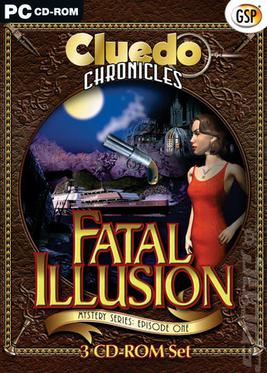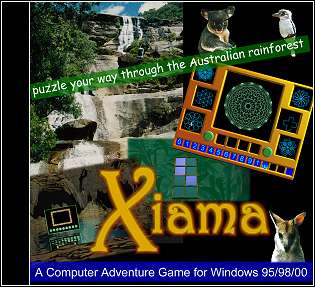Interactive fiction (IF) is software simulating environments in which players use text commands to control characters and influence the environment. Works in this form can be understood as literary narratives, either in the form of Interactive narratives or Interactive narrations. These works can also be understood as a form of video game, either in the form of an adventure game or role-playing game. In common usage, the term refers to text adventures, a type of adventure game where the entire interface can be "text-only", however, graphical text adventure games, where the text is accompanied by graphics still fall under the text adventure category if the main way to interact with the game is by typing text. Some users of the term distinguish between interactive fiction, known as "Puzzle-free", that focuses on narrative, and "text adventures" that focus on puzzles.

Escape from Monkey Island is an adventure game developed and released by LucasArts in 2000. It is the fourth game in the Monkey Island series, and the sequel to the 1997 videogame The Curse of Monkey Island. It is the first game in the series to use 3D graphics and the second game to use the GrimE engine, which was upgraded from its first use in Grim Fandango.

From the late 1980s to the early 2000s, LucasArts was well known for their point-and-click graphic adventure games, nearly all of which received high scoring reviews at the time of their release. Their style tended towards the humorous, often irreverent or slapstick humor, with the exceptions of Loom and The Dig. Their game design philosophy was that the player should never die or reach a complete dead-end, although there were exceptions.

Gobliiins is a puzzle adventure video game series, consisting of five entries, released by Coktel Vision for the Amiga, Atari ST, DOS, Macintosh, iOS and Windows platforms. The first three titles were released in the early 1990s, the fourth in 2009, and fifth in 2023. The visual look of the series and its characters were created by French artist Pierre Gilhodes, whose style was used in another game from Coktel Vision: Woodruff and the Schnibble of Azimuth.

Castlevania II: Simon's Quest is a 1987 action role-playing game developed and published by Konami. It was originally released in Japan in 1987 for the Famicom Disk System, and in North America in 1988 for the Nintendo Entertainment System. It is the second Castlevania game released for the NES, following the original Castlevania (1986). Set seven years after the events of the first installment, the player once again assumes the role of vampire hunter Simon Belmont, who is on a journey to undo a curse placed on him by Dracula at the end of their previous encounter. Dracula's body was split into five parts, which Simon must find and bring to the ruins of Castle Dracula in order to defeat him. The game deviates from the traditional platforming of its predecessor, incorporating role-playing and open world elements.

Numerous video games based on the Jurassic Park franchise have been released. Developers Ocean Software, BlueSky Software and Sega produced various games in 1993, coinciding with the first film, Jurassic Park. In 1997, several developers, including DreamWorks Interactive and Appaloosa Interactive, produced various games for nine different platforms to coincide with the release of the film The Lost World: Jurassic Park.

Shivers is a single-player horror-themed PC adventure game, released on CD-ROM by Sierra On-Line in November 1995. It was developed with Sierra's Creative Interpreter. Being the first Sierra first-person adventure game, Shivers was compared to contemporary Myst and The 7th Guest, gaining praise mostly for its atmosphere. The game takes place in a fictitious haunted museum.
An escape room video game, also known as escape the room, room escape, or escape game, is a subgenre of point-and-click adventure game which requires a player to escape from imprisonment by exploiting their surroundings. The room usually consists of a locked door, objects to manipulate, and hidden clues or secret compartments. The player must use the objects to interact with other items in the room to reveal a way to escape. Escape the room games were born out of freeware browser games created in Adobe Flash, but have since become most popular as mobile games for iOS and Android. Some examples include Crimson Room, Viridian Room, MOTAS, and Droom. The popularity of these online games has led to the development of real-life escape rooms all around the world.

Phantasmagoria: A Puzzle of Flesh is an interactive movie point-and-click adventure game released by Sierra On-Line. The game was released in North America on November 26, 1996. Though technically a sequel to Roberta Williams' 1995 game Phantasmagoria, Puzzle of Flesh shares no connections with its predecessor in plot nor characters, as Sierra initially intended the Phantasmagoria title to be a horror anthology, with each installment of a different story and style. While not a critical or commercial success, A Puzzle of Flesh, like its predecessor, is remembered for its controversial violent and sexual content, which led the game to be heavily censored or banned outright in several European and Oceanic countries.

Boomzap Entertainment is a casual games developer registered in Singapore with a virtual office environment. It was formed in 2005 and has released 50 games to date that are ported on various platforms. Boomzap has developed for Microsoft Windows, Mac OS X, Nintendo DS, Wii, iOS, and Android. Its games are available on games portals such as Big Fish Games, Yahoo!, WildTangent, GameHouse, Google Play, Amazon, iTunes, Steam and others.
An adventure game is a video game genre in which the player assumes the role of a protagonist in an interactive story, driven by exploration and/or puzzle-solving. The genre's focus on story allows it to draw heavily from other narrative-based media, such as literature and film, encompassing a wide variety of genres. Most adventure games are designed for a single player, since the emphasis on story and character makes multiplayer design difficult. Colossal Cave Adventure is identified by Rick Adams as the first such adventure game, first released in 1976, while other notable adventure game series include Zork, King's Quest, Monkey Island, Syberia, and Myst.

King's Quest: Mask of Eternity is a hybrid point-and-click adventure and action-adventure video game developed and published by Sierra Studios in 1998. It was the eighth official game in the King's Quest series, the first and only game in the main series where the main character is neither King Graham nor a member of his family, as well as the first in the series to use a full 3D engine as opposed to the 2D cartoon or pixel style of the earlier games and the first to omit the sequel numbering system on box artwork and title screen.
There have been several King's Quest fangames both original and retellings/remakes of the original games that have been released by various developers.

The Cave is a puzzle-platform, adventure game developed by Double Fine Productions and published by Sega in January 2013 on the PlayStation Network, Nintendo eShop and Xbox Live Arcade storefronts via the PlayStation 3, Wii U and Xbox 360 consoles and on Steam for Microsoft Windows, OS X and Linux. It was later released on October 3, 2013 on iOS devices and Android. On December 2, 2013 it was also released on the Ouya. The game has been delisted from console storefronts as of April 2, 2018, making it a Steam exclusive until 2023.

Clue Chronicles: Fatal Illusion is a Windows point-and-click adventure game based on the Cluedo franchise, known as Clue in North America. It is a reinterpretation and adaption of the Clue board game as an adventure game including many of the original characters. The game was distributed with a variety of covers, each featuring a different murder weapon.

Jewels of the Oracle is a 1995 adventure game developed by ELOI Productions and published by Discis Knowledge Research Inc. It was released on Macintosh, PlayStation, Sega Saturn, and Windows. A sequel developed by Bardworks and published by Hoffman and Associates was released in 1998 entitled Jewels II: The Ultimate Challenge.

Mummy: Tomb of the Pharaoh is a point-and-click adventure video game released on August 31, 1996, by Interplay Productions on Windows and by MacPlay, a division of Interplay Productions at the time, on Macintosh. It is a sequel to Frankenstein: Through the Eyes of the Monster. The game was developed by Amazing Media, directed and produced by Jeff McDonald, Keith Metzger, and Loring Casartelli, written by McDonald and Metzger, and composed by Márcio Câmara. Malcolm McDowell stars as Stuart Davenport, one of the main characters of the game.

The Forgotten: It Begins is a 1999 adventure/puzzle video game developed by Ransom Interactive and published by DreamCatcher Interactive. A sequel was to be released called The Forgotten II: The Collection. The Forgotten narrative was originally supposed to last over 7 games ("modules"), but these were never completed.

Xiama is a 2000 puzzle adventure game by Townsville-based Australian studio Mulawa Dreaming, released on Windows. The game was self-published by its developer, Peter Hewitt, off his website and at a stall in Townville's "Cotter's Markets".















